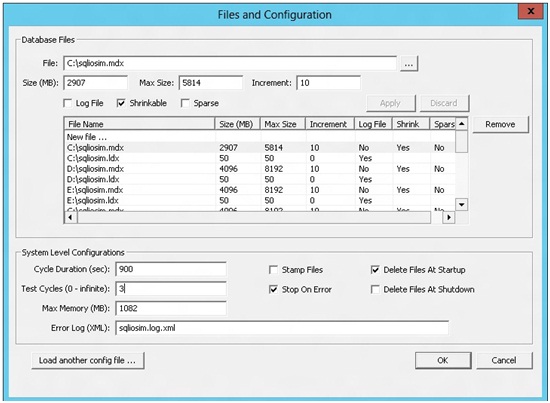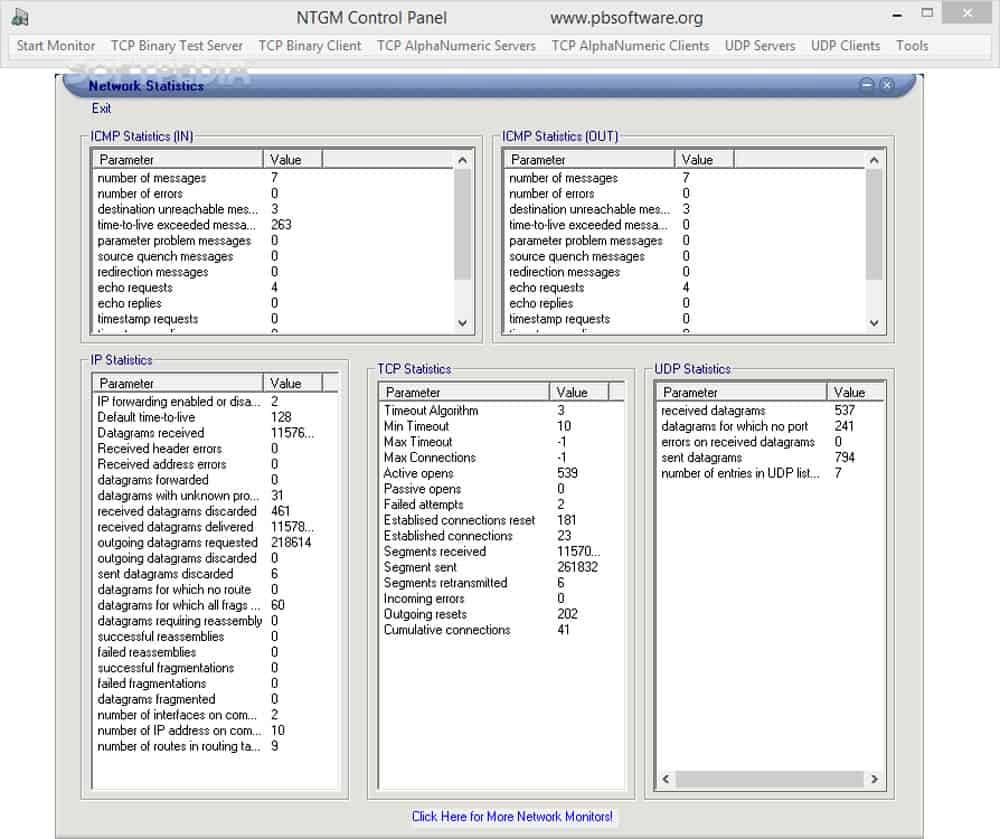- Website: Price: From $0. Compared to what we’ve shown so far, Loader is a much simpler and more basic tool. Its free plan supports load testing with up to 10,000 virtual users which is enough for most moderate traffic websites.
- Test Description. Users Probing the limits of a web server: Requesting a simple HTML page every 2 seconds in a ramp test: 4,000: Details: In this test we wanted to see the difference between two web server programs on the same machine. 1,000: Details: In this test we are trying to find the maximum bandwidth a web server can serve.
- Benefits Of Using WAN Stress Testing Tools. Let’s have a look at the benefits of using WAN stress testing tools. First and foremost, they take care of generating data to be transferred. You don’t have to find or create a test file. Some tools will generate random data, other will send a known sequence of bits.
By: John Sterrett | Updated: 2012-07-18 | Comments (15) | Related: More >Testing
As such, in order to find out if the memory will cause any problems, the most important stress test to run on a new system is the memory stress test, and the best free tool for the job is Memtest86+. Although Memtest86+ isn’t an application in Windows, Memtest86+ is easily be loaded onto a bootable USB drive via an automatic installer.
Problem
I have a stored procedure and I need to add additional stress and test thestored procedureusing a random set of parameters before it can be pushed to production. I don'thave a budget for stress testing tools. Can you show me how to accomplish thesegoals without buying a third party tool?
Solution
Yes, theSQLQueryStresstool provided byAdam Machaniccan be used to apply additional stress when testing your stored procedures. Thistool can also be used to apply a dataset as random parameter values when testingyour stored procedures. You can also read more about SQLStressTest on the toolsdocumentation page to find more details about how you can use the tool.
For the purpose of this tip we are going to use the uspGetEmployeeManagers storedprocedure in theAdventureWorks2008R2 database. You can exchange this with your stored procedureto walk through this tip in your own environment.
Step 1
Our first step is to test the following stored procedure with a test parameter.This is done in Management Studio using the query shown below.

Now that we know we have a working stored procedure and a valid parameter thatreturns data we can get started with theSQLStressTool.Once you downloaded and installed SQLQueryStress, fire the tool up and pastein the code that you used in Management Studio. Next, we need to click on the databasebutton to configure our database connection.
Step 2 - Configure Database Connectivity
Now that we clicked on the database button we will want to connect to our AdventureWorksdatabase. In this example I am using a instance named 'r2' on my localhost. We willconnect with windows authentication and our default database will be AdventureWorks2008R2.Once this is done we will click on Test Connection and click on the 'OK' box inthe popup window. We'll see the Connection Succeeded message to verify that ourconnection settings are connect.
Step 3 - Clear Proc Cache
Before we execute our stored procedure using SQLQueryStress we are going to clearout the procedure cache so we can track the total executions of our stored procedure.This shouldn't be done on a production system as this can causesignificant performance problems. You would have to recompile all user objects toget them back into the procedure cache. We are doing this in this walkthrough tipto show you how we can count the total executions of the stored procedure.
NOTE: In SQL Server 2008 and up you can actually clear a specificplan from the buffer pool. In this example we are clearing out all plan's incaseyour using SQL 2005. Once again, this shouldn't be done on a productionsystem . Pleasesee BOL for a specific example on clearing out a single plan.
Step 4 - Execute Stored Procedure Using SQLQueryStress
Now that we have established our connection and specified a default databasewe are going to execute our stored procedure specified in step one. You can executethe stored procedure once by making sure the number of interations and number ofthreads both have the value of 'one.' We will go over these options in more detailsa little later in the tip. Once those values are set correctly you can execute thestored procedure once by clicking on the 'GO' button on the top right side of theSQLQueryStress tool.
Once the stored procedure execution completes you will see that statistics aregenerated to help give you valuable feedback towards your workload. You can seethe iterations that completed. In this case we only executed the stored procedureonce. You can also see valuable information for actual seconds, CPU, Logical readsand elapsed time as shown in the screen shot below.
Step 5 - View Total Executions via T-SQL
Now we will execute the following T-SQL script below, which will give us theexecution count for our stored procedure. We just cleared the procedure cache soyou will get an execution count of one as shown in the screen shot below.
Step 6 - Using SQLQueryStress to Add Additional Stress with Multiple Threads.
Now that we have gone over the basics of executing a stored procedure with SQLQueryStresswe will go over adding additional stress by changing the values for Number of Threadsand Number of Iterations. The number of Iterations means the query will be executedthis amount of times for each thread that is specified. The numbers of threads specifyhow many concurrent threads (SPIDS) will be used to execute the number of iterations.
Being that we changed the number of iterations to five and the number of threadsto five we will expect the total number of iterations completed to be twenty-five.The iterations completed is twenty-five because we used five threads and had fiveiterations that were executed for each thread. Below is a screen shot of thethe workload completed after we clicked on the 'GO' button with valuable averagestatistics during the workload.
File Server Stress Test Tool Set
If we rerun our T-SQL script from step 5, you will see that there is a totalof twenty-six executions for the uspGetEmployeeManagers stored procedure. This includesour initial execution from step 4 and the additional stress applied in step 6.
Step 7 - Use Random Values for Parameters with SQLQueryStress
Next, we are going to cover using a dataset to randomly provide parameters toour stored procedure. Currently we use a hard coded value of eight as the valuefor the BusinessEntityID parameter. Now, we are going to click on the 'ParameterSubstitution' button to use a T-SQL script to create a pool of values that willbe used during our stress testing of the uspGetEmployeeManagers stored procedure.
Once the parameter substitution window opens we will want to copy our T-SQL statementprovided below that will generate the BusinessEntityID values we would want to passinto our stored procedure.
Once you added the T-SQL script, you would want to select the column you wouldlike to map to the parameter used for your stored procedure.
Finally, the last part of this step is to drop the hard coded value assignmentfor the stored procedure. This way the parameter substitution will be used for theparameter value.
Step 8 - Wrap-up Results
To wrap up this tip, we have gone over controlling a workload to provide additionalstress and randomly substituting parameters to be used for your workload replay.If you capture aSQL traceand replay the workload you should see a similar output as the one provided in thescreen shot below. Looking at the screen shot below you will notice that each thread(SPID) has five iterations. Also, you will notice that the values for the businessentityidprovided are randomly selected from our block of code provided for the parametersubstitution.
Next Steps
- If you need to do some load testing, start usingSQLQueryStresstool.
- Review severaltips on SQL Profiler and trace
- Revew tips on working withStored Procedures
Last Updated: 2012-07-18
About the author
View all my tips
By: John Sterrett | Updated: 2012-07-18 | Comments (15) | Related: More >Testing

Problem
I have a stored procedure and I need to add additional stress and test thestored procedureusing a random set of parameters before it can be pushed to production. I don'thave a budget for stress testing tools. Can you show me how to accomplish thesegoals without buying a third party tool?
Solution
Yes, theSQLQueryStresstool provided byAdam Machaniccan be used to apply additional stress when testing your stored procedures. Thistool can also be used to apply a dataset as random parameter values when testingyour stored procedures. You can also read more about SQLStressTest on the toolsdocumentation page to find more details about how you can use the tool.
For the purpose of this tip we are going to use the uspGetEmployeeManagers storedprocedure in theAdventureWorks2008R2 database. You can exchange this with your stored procedureto walk through this tip in your own environment.
Step 1
Our first step is to test the following stored procedure with a test parameter.This is done in Management Studio using the query shown below.
Now that we know we have a working stored procedure and a valid parameter thatreturns data we can get started with theSQLStressTool.Once you downloaded and installed SQLQueryStress, fire the tool up and pastein the code that you used in Management Studio. Next, we need to click on the databasebutton to configure our database connection.
Step 2 - Configure Database Connectivity
Now that we clicked on the database button we will want to connect to our AdventureWorksdatabase. In this example I am using a instance named 'r2' on my localhost. We willconnect with windows authentication and our default database will be AdventureWorks2008R2.Once this is done we will click on Test Connection and click on the 'OK' box inthe popup window. We'll see the Connection Succeeded message to verify that ourconnection settings are connect.
Step 3 - Clear Proc Cache
Before we execute our stored procedure using SQLQueryStress we are going to clearout the procedure cache so we can track the total executions of our stored procedure.This shouldn't be done on a production system as this can causesignificant performance problems. You would have to recompile all user objects toget them back into the procedure cache. We are doing this in this walkthrough tipto show you how we can count the total executions of the stored procedure.
NOTE: In SQL Server 2008 and up you can actually clear a specificplan from the buffer pool. In this example we are clearing out all plan's incaseyour using SQL 2005. Once again, this shouldn't be done on a productionsystem . Pleasesee BOL for a specific example on clearing out a single plan.
Step 4 - Execute Stored Procedure Using SQLQueryStress
Now that we have established our connection and specified a default databasewe are going to execute our stored procedure specified in step one. You can executethe stored procedure once by making sure the number of interations and number ofthreads both have the value of 'one.' We will go over these options in more detailsa little later in the tip. Once those values are set correctly you can execute thestored procedure once by clicking on the 'GO' button on the top right side of theSQLQueryStress tool.

Once the stored procedure execution completes you will see that statistics aregenerated to help give you valuable feedback towards your workload. You can seethe iterations that completed. In this case we only executed the stored procedureonce. You can also see valuable information for actual seconds, CPU, Logical readsand elapsed time as shown in the screen shot below.
Step 5 - View Total Executions via T-SQL
Now we will execute the following T-SQL script below, which will give us theexecution count for our stored procedure. We just cleared the procedure cache soyou will get an execution count of one as shown in the screen shot below.
Step 6 - Using SQLQueryStress to Add Additional Stress with Multiple Threads.
Now that we have gone over the basics of executing a stored procedure with SQLQueryStresswe will go over adding additional stress by changing the values for Number of Threadsand Number of Iterations. The number of Iterations means the query will be executedthis amount of times for each thread that is specified. The numbers of threads specifyhow many concurrent threads (SPIDS) will be used to execute the number of iterations.
Being that we changed the number of iterations to five and the number of threadsto five we will expect the total number of iterations completed to be twenty-five.The iterations completed is twenty-five because we used five threads and had fiveiterations that were executed for each thread. Below is a screen shot of thethe workload completed after we clicked on the 'GO' button with valuable averagestatistics during the workload.
If we rerun our T-SQL script from step 5, you will see that there is a totalof twenty-six executions for the uspGetEmployeeManagers stored procedure. This includesour initial execution from step 4 and the additional stress applied in step 6.
Step 7 - Use Random Values for Parameters with SQLQueryStress
Next, we are going to cover using a dataset to randomly provide parameters toour stored procedure. Currently we use a hard coded value of eight as the valuefor the BusinessEntityID parameter. Now, we are going to click on the 'ParameterSubstitution' button to use a T-SQL script to create a pool of values that willbe used during our stress testing of the uspGetEmployeeManagers stored procedure.
Once the parameter substitution window opens we will want to copy our T-SQL statementprovided below that will generate the BusinessEntityID values we would want to passinto our stored procedure.
Once you added the T-SQL script, you would want to select the column you wouldlike to map to the parameter used for your stored procedure.
Finally, the last part of this step is to drop the hard coded value assignmentfor the stored procedure. This way the parameter substitution will be used for theparameter value.
Step 8 - Wrap-up Results
To wrap up this tip, we have gone over controlling a workload to provide additionalstress and randomly substituting parameters to be used for your workload replay.If you capture aSQL traceand replay the workload you should see a similar output as the one provided in thescreen shot below. Looking at the screen shot below you will notice that each thread(SPID) has five iterations. Also, you will notice that the values for the businessentityidprovided are randomly selected from our block of code provided for the parametersubstitution.
Next Steps
- If you need to do some load testing, start usingSQLQueryStresstool.
- Review severaltips on SQL Profiler and trace
- Revew tips on working withStored Procedures
Last Updated: 2012-07-18

Microsoft Stress Test
About the author
View all my tips
